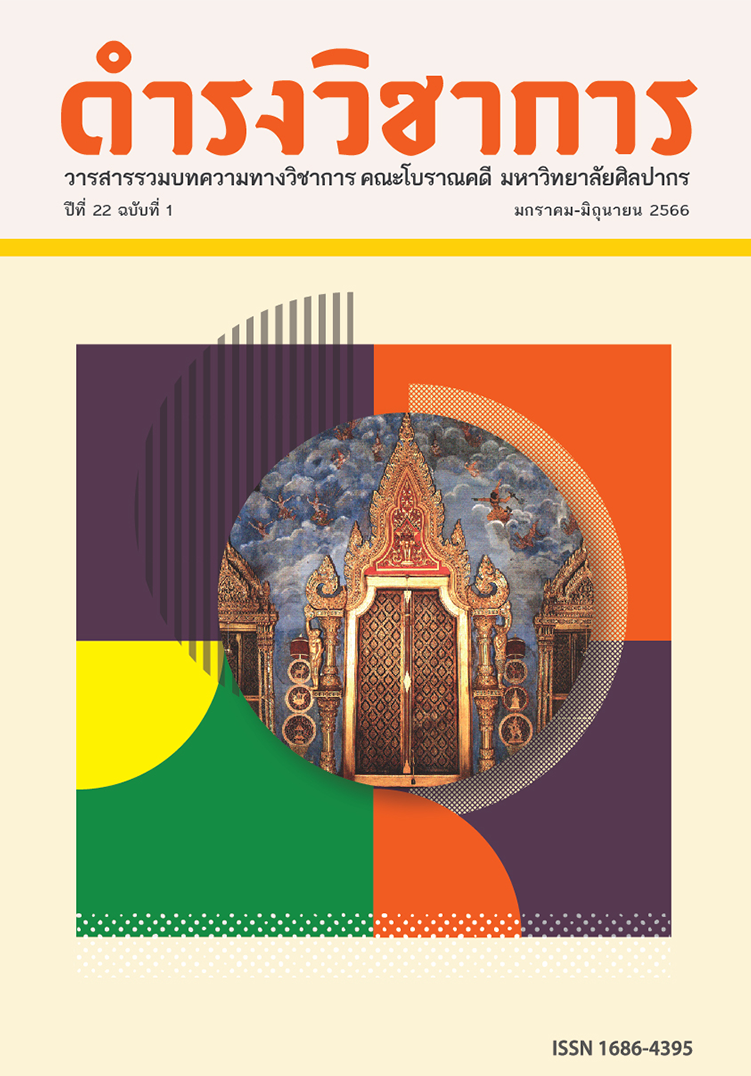A Study of the Pattern on the Scripture Cabinets from the Late Ayutthaya Period to King Rama II's Reign in the Santiwan Library
Keywords:
Scripture Cabinet, Gilded Cabinet, Wat Phra Chetuphon Wimon Mangkhalaram, Santiwan LibraryAbstract
Santiwan Library is situated in the monastery area of Wat Phra Chetuphon Wimon Mangkhalaram. This place serves as an educational place for monks and novices to study the Abhidhamma Pitaka, and as a storage of books, textbooks, old Tripitaka on ancient palm leaves, and for storing many scripture cabinets from various periods. However, previously there was no study to identify each scripture cabinet period. Thus, this study aims to identify their period through the study of decorative patterns. This study uses 4 sample cabinets from the late Ayutthaya period to the early Rattanakosin period, in the reign of King Phra Phuttha Lertlah Naphalai, which is Nameless Cabinet No.2, Santiwan Cabinet No.13, Santiwan Cabinet No.18, Santiwan Cabinet No.29
The results determined the periods as follows: Nameless Cabinet No.2 is from the late Ayutthaya period, indicated by its delicate and lively scenery pattern. Santiwan Cabinet No.13 is dated between the late Ayutthaya period and Thonburee period, as indicated by its soft and waving Kranok drawing and its raised Upper Kab and Lower Kab patterns, which was developed from the Kab Pai pattern. For Santiwan Cabinet No.18, it is from King Rama I's reign, evidenced by its slim, coiled vine, and slim Kranok Plaew, plus the enlarged spacing between patterns. Lastly, Santiwan Cabinet No.29 is from King Rama II's reign, indicated by a somewhat plumper Kranok Plaew, strong drawing lines, and visibly orderly pattern. It is the last period that still retains some of the late Ayutthaya drawing methods.
References
ก่องแก้ว วีระประจักษ์, 2529. ตู้ลายทองภาค 2 สมัยรัตนโกสินทร์ เล่ม 1. กรุงเทพฯ: สำนักงานเสริมสร้างเอกลักษณ์ของชาติ.
_______, 2531. ตู้ลายทองภาค 2 สมัยรัตนโกสินทร์ เล่ม 3. กรุงเทพฯ: สำนักงานเสริมสร้างเอกลักษณ์ของชาติ.
_______, 2564ก. ตู้ลายทอง ภาค 1 สมัยอยุธยาและธนบุรี. กรุงเทพฯ: สำนักหอสมุดแห่งชาติ กรมศิลปากร.
_______, 2564ข. ตู้ลายทอง ภาค 2 สมัยรัตนโกสินทร์ เล่มที่ 1. กรุงเทพฯ: สำนักหอสมุดแห่งชาติ กรมศิลปากร.
นิวัติ กองเพียร, 2526. หอพระไตรปิฎก วัดระฆังโฆสิตาราม. กรุงเทพฯ: บริษัทเชลล์ในประเทศไทย.
ประภัสสร์ ชูวิเชียร, 2562. ศิลปะกรุงธนบุรี. กรุงเทพฯ: มติชน.
ราชบัณฑิตยสถาน, 2549. ศิลปกรรมล้ำค่าสมัยรัตนโกสินทร์. กรุงเทพฯ: ราชบัณฑิตยสถาน.
_______, 2561. พจนานุกรมศัพท์ลายไทย ฉบับราชบัณฑิตยสถาน. กรุงเทพฯ: ราชบัณฑิตยสถาน.
ศักดิ์ชัย สายสิงห์, 2563. พุทธศิลป์สมัยรัตนโกสินทร์: พัฒนาการของงานช่างและแนวคิดที่ปรับเปลี่ยน. กรุงเทพฯ: เมืองโบราณ.
สันติ เล็กสุขุม, 2532. ลวดลายปูนปั้นแบบอยุธยาตอนปลาย (พ.ศ. 2172-2310). กรุงเทพฯ: มูลนิธิเจมส์ ทอมป์สัน.
_______, 2553. พัฒนาการของลายไทย: กระหนกกับเอกลักษณ์ไทย. กรุงเทพฯ: เมืองโบราณ.
_______, 2560. ศิลปะอยุธยา: งานช่างหลวงแห่งแผ่นดิน. นนทบุรี: เมืองโบราณ.
เสนอ นิลเดช, 2545. ประวัติศาสตร์สถาปัตยกรรมไทย. กรุงเทพฯ: โรงพิมพ์มหาวิทยาลัยธรรมศาสตร์.
แสงโสม เกษมศรี และ วิมล พงศ์พิพัฒน์, 2515. ประวัติศาสตร์สมัยกรุงรัตนโกสินทร์ รัชกาลที่ 1 ถึงรัชกาลที่ 3 (พ.ศ. 2325-2394). พระนคร: มิตรนราการพิมพ์.
หอสมุดแห่งชาติ กรมศิลปากร, 2542. สมุดภาพไตรภูมิฉบับกรุงศรีอยุธยา–ฉบับกรุงธนบุรี. กรุงเทพฯ: กรมศิลปากร.
Downloads
Published
Issue
Section
License
Copyright (c) 2023 Damrong Journal of The Faculty of Archaeology Silpakorn University

This work is licensed under a Creative Commons Attribution-NonCommercial-NoDerivatives 4.0 International License.
บทความนี้เป็นผลงานของข้าพเจ้าแต่เพียงผู้เดียว และ/หรือเป็นผลงานของข้าพเจ้าและผู้ร่วมงาน ตามชื่อที่ระบุในบทความจริง และเป็นผลงานที่มิได้ถูกนำเสนอหรือตีพิมพ์ที่ใดมาก่อน





